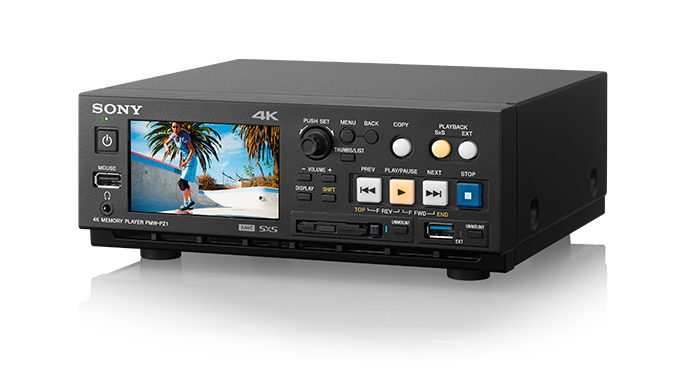Documentary: Tell your story
Shoot the documentary you've dreamed of with powerful cameras, lenses and optical formats

Thanks to Sony, there’s never been a better time to shoot documentaries. The choices in cameras, optical formats and lenses have never been better. And whether you prefer to shoot handheld, from the shoulder or on a tripod, Sony has what it takes to tell your story as never before.
Digital technology has transformed documentary shooting. But it hasn’t changed the human body or the laws of optics. Naturally, Sony documentary cameras offer the most advanced digital technology anywhere. But they also respect your practical requirements for shooting styles, lens choices and more.
Not so long ago, documentary shooting was all about a single image size: 16mm film. Now you have a choice: the larger Super 35 format that cinematically flatters your subjects or the 2/3-inch Electronic Newsgathering format common to live TV and sports. And if you still want the 16mm look, Sony accommodates that as well.
News-style 2/3-inch
There are good reasons why 2/3-inch shoulder mount cameras dominate the run and gun, rough and tumble world of TV news. Compared to Super 35, it’s far easier to maintain proper focus. The high-zoom-ratio lenses give you flexibility to frame your shots. And the servo zoom, iris and focus controls all fall readily to hand, perfect for a single camera operator.
For any given lens focal length, the smaller 2/3-inch image applies a 2.5x crop factor versus Super 35.
[1] 2/3″
[2] Super 35
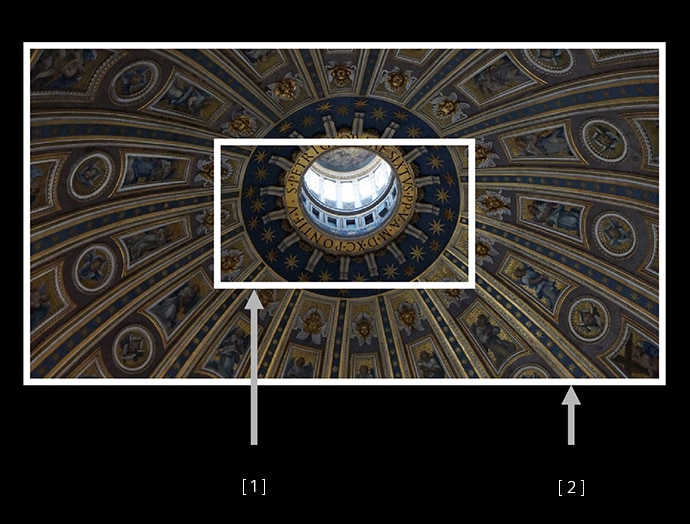

Cinematic Super 35
The image format of feature films, Super 35 excels at selective focus that guides viewer attention in the frame. You can compose beautiful shots that blur the background and flatter your subjects. Other things being equal, the physics of a larger image area also grant Super 35 tremendous low-light sensitivity, amazing resolution and greatly reduced diffraction.
Rob Scribner, Owner, Sky Tower Films, makes use of Super 35 selective focus for his film, ‘Warbird Pilot’, a documentary about a rare group of people committed to keeping the legacy of America’s vintage combat aircraft in flying condition.
The best of both worlds
If you’d like the advantages of large and small sensors in a single camera, you owe it to yourself to check out the 2K Center Scan mode now available on the F55, F5, FS7 and FS5. In these cameras, standard shooting uses the full surface of the Super 35 sensor, maintaining the full Super 35 field of view. But 2K Center Scan establishes a half-size ‘window’ within the 4K frame. This provides a 2x crop factor, which is almost like doubling the focal length of your 35mm glass. For example, your 50 mm prime acts like a 100, with no light loss, no degradation in lens quality. 2K Center Scan is also great for use with 16mm PL lenses. On the F5 and F55, the feature can even be used with broadcast 2/3-inch B4 mount lenses, via Sony’s adapters, sold separately.
2K Center Scan helps make selected cameras even more versatile.
[1] 2K center scan
[2] 4K full scan
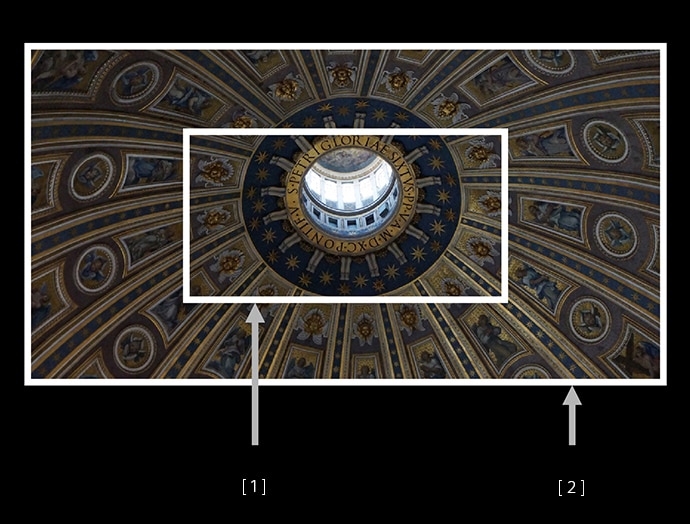
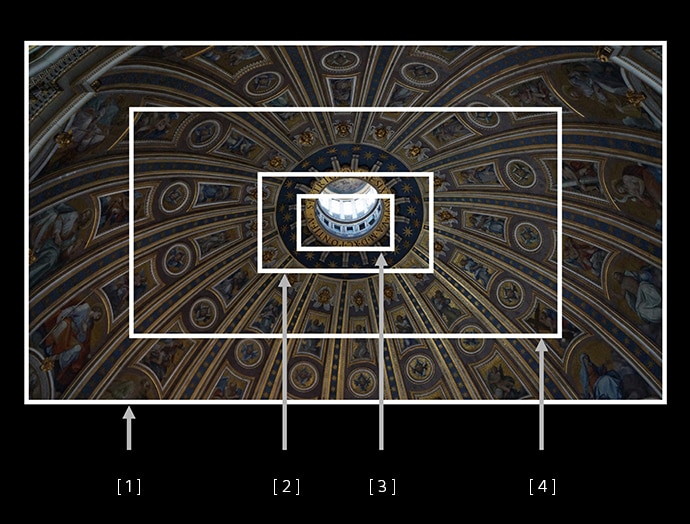
Other image sizes
As a full-line manufacturer of consumer, prosumer and professional cameras, Sony has you covered for special-purpose documentary shooting. We offer the phenomenal FDR-X1000V 4K Action Cam point of view camera with relatively small 1/2.3-inch sensor, the α7S II and α7R II 35mm full frame 4K cameras and a full range of compact professional cameras for light, nimble, run and gun shots.
Sony offers a full range of cameras and image sizes for special purpose shooting. Each image size has its own distinct crop factor.
[1] 35mm full frame
[2] 2/3″
[3] 1/3″
[4] Super 35
Lenses: Change lens mounts without changing cameras
More than an appendage to the camera, the lens is the central tool in visual storytelling. In the old days, a camera had one lens mount, appropriate for only one type of interchangeable lens. Today, Sony documentary camcorders have moved far ahead. While the PXW-X500 and PXW-X400 accept 2/3-inch B4 lenses, the F55, F5, FS7 and FS5 all have extremely shallow flange focal distances. So they accept an incredible range lenses via adapters.
2/3-inch B4 mount lenses
Designed for 2/3-inch sensors, B4 mount lenses are so popular because they answer a broad range of photographic needs. The lenses deliver incomparable zoom range. So you can frame landscapes, establishing shots, interviews, and wildlife, all with a single lens. For example, 40x zoom — unheard of in other types of glass — is an attractive choice in B4.
B4 lenses like the Fujinon® HA18x5.5m shown here, combine light weight and compact size with powerful zoom.
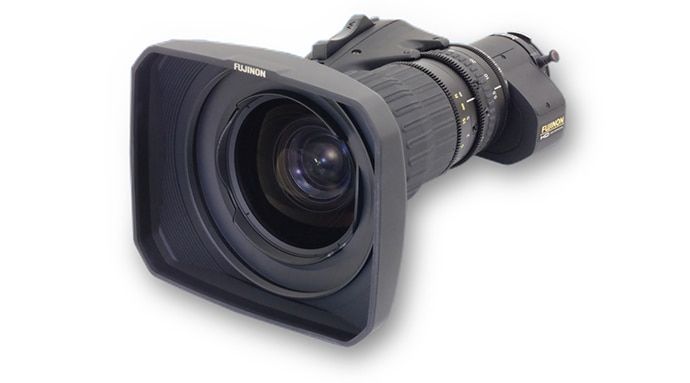

Servo zoom gives you the ability to do careful, controlled re-framing during a shot. Control is available at the camera front, for shoulder mount operation, or at the rear, for tripod shots. The B4 lens mount even gives you access to gigantic field and studio box lenses, for ultra-high powered 60x and 100x zoom.
Extend your reach. The Fujinon 99x power zoom field lens is mounted to the F55 camera using the LA-FZB2 optical adapter and the CA-4000 power booster.
Cine PL lenses
From Cooke to Angenieux, Fujinon, Zeiss and Leica, 35mm Positive Lock (PL) mount motion picture lenses inspire critical appreciation and passion among the professionals who use them. PL lenses are generally offered in fixed focal length (primes) or in modest-range zooms. These lenses typically offer smooth, continuous control of iris and robust gears for external control of focus, iris and zoom. Made for motion imaging, they’re designed to minimize ‘breathing’, the unwanted change in image magnification during focus. The zoom lenses also minimize ‘ramping’, the unwanted change in iris during zoom.
Cinematographers have found that Sony’s PL prime lenses deliver exceptional value for the money.
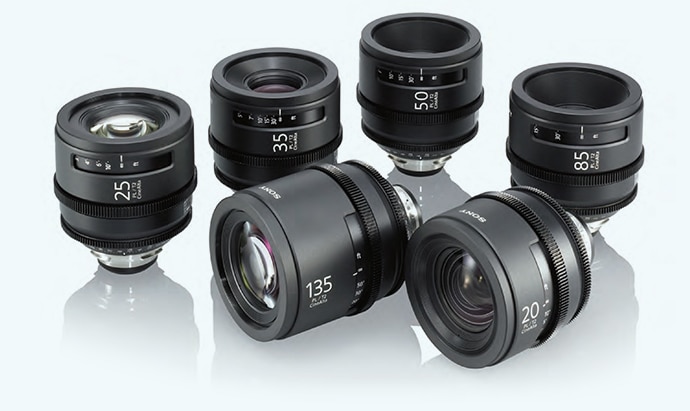
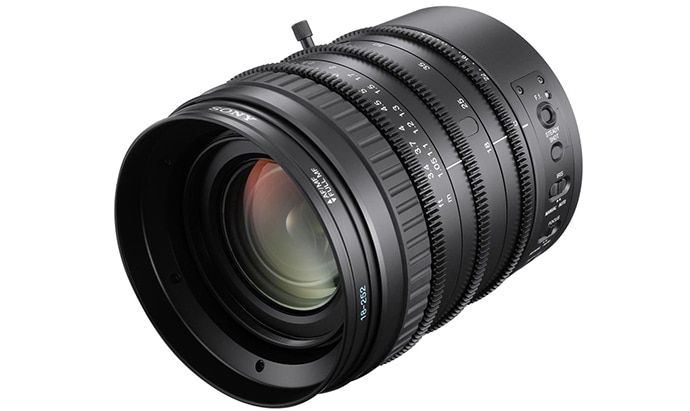
FZ mount lenses
Removing the supplied PL mount adapter from the F55 and F5 reveals the native FZ lens mount. This supports the SCL-Z18X140, a 14x servo zoom lens. Ideal for run and gun projects, the lens brings surprising capabilities to Super 35mm shooting: auto/manual focus, auto/manual iris, servo/manual zoom and incredibly effective optical image stabilization. Servo zoom, focus and iris control requires the CBK-DCB01 interface.
Designed for the native FZ mount of the F55 and F5, Sony’s SCL-Z18X140 features 14x servo zoom, auto/manual focus, auto/manual iris and image stabilization.
Sony E-Mount lenses
Endowed with the α E-Mount system, the Sony PXW-FS7 and FS5 can accept a growing range of compact, lightweight, cost effective Sony E-Mount lenses. Where typical SLR lenses are designed for stills, every E-Mount lens is built from the ground up for moving pictures. In still photography, noisy power auto focus and power iris are not problems. In motion pictures, these noises can be picked up by on-board microphones. Sony E-Mount lenses minimize the noise. In still lenses, clicked detents for each iris F-stop are common. In motion pictures, the clicks make for visible jumps in exposure when you adjust during a shot. Sony E-Mount lenses eliminate the clicks. In still lenses, there’s no need for smooth zoom during a shot. So power or ‘servo’ zoom is unknown in SLR lenses. But Sony now offers a trio of E-Mount servo zoom lenses that will change the way documentaries are shot.
A game changer for doc shooters: Sony’s SEL-P28135G power zoom lens mounted on the PXW-FS7.
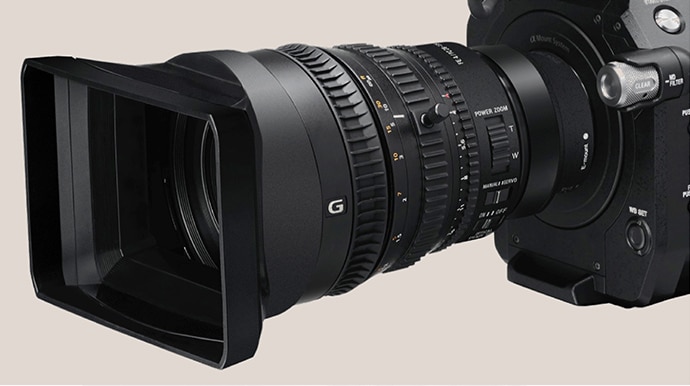
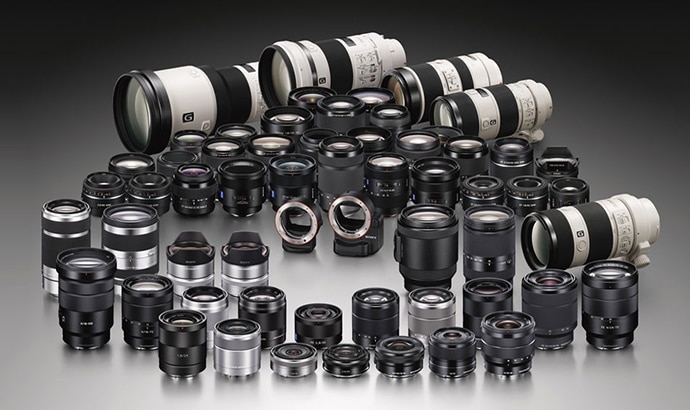
There’s nothing else like Sony’s E-Mount servo zooms, the SEL-P28135G, SELP18105G and SEL-P18200. They exploit the full Super 35 image size, while providing smoother zoom than you could accomplish by hand. Meticulous optical design maintains axial image consistency across the zoom range. Constant aperture eliminates unwanted exposure changes during a zoom. Sony’s Optical SteadyShot® image stabilization reduces the effects of camera shake, even when you’re on the move. Internal focus will not change the overall length of the lens. And internal zoom (on the SEL-P28135G and SEL-P18105G) means the front of the lens does not extend, so it will not interfere with your matte box.
Sony E-Mount cameras can also accept α A-Mount system lenses, through Sony adapters. This opens up terrific glass including the 16mm F2.8 fisheye, the 500mm F4 G SSM super telephoto and the legendary 135mm F2.8 (T4.5) Smooth Transition Focus (STF).
Sony LA-EA series adapters enable the FS7 to accept the entire range of α A-Mount lenses, in addition to the growing range of E-Mount glass.
Third-party SLR lenses
Thanks to very short flange focal lengths, the Sony F55, F5, FS7 and FS5 support Canon® EF and other third-party SLR lenses via third-party adapters. This means you can attach many types of small, lightweight, cost-effective glass.You’ve got access to tons of specialty lenses, including tilt-shift, super telephoto and fisheye. In fact, you may be able to use the SLR lenses you already own.The adapters typically include no glass elements and therefore do not lose light.
The OptiTek® Canon ProLock Mark II adapter enables you to mount Canon® EF lenses on the F5 and F55 and enjoy electronic aperture control. Also shown is the OptiTek OptiTron 2 follow focus unit, which provides wired or wireless focus and iris control.

Ergonomics: Matching your shooting style
All camera operators worth their pay can adapt a camera for various shooting situations. On a tripod? No problem. Shoulder mount? Fine. Handheld? Let’s go. But experienced operators know there’s a world of difference between cameras that are rigged for a shooting style and cameras meticulously designed for that specific application. If you’re going to spend a large part of your working life shouldering or hand-holding a camera, it pays to take the ergonomics very seriously. Sony certainly does.
Shoulder mount balance
The great advantage of shoulder mount is the ability to balance the lens on the front with the battery in back, and then adjust the shoulder arch fore or aft to fine tune that balance perfectly. With the camera correctly balanced, your right wrist and forearm won’t be carrying the weight of the camera. So you can keep on shooting for hours. A purpose-designed shoulder mount camera also places the viewfinder in the right spot. And it presents start/stop, zoom, focus, iris and neutral density filter controls right where muscle memory tells you they should be.
The Sony PXW-X500 and PXW-X400 are classic 2/3-inch cameras, designed from the outset to work on your shoulder. The Sony F55 and F5 accomplish a similar result with a brilliant accessory: the CBK-55BK shoulder mount dock. A rear module with audio controls, wireless mic receiver slot, inputs and outputs help balance the lens. A forward control pod includes an industry-standard rosette plus adjustments for Gain, ISO, White Balance and more. And the shoulder arch has generous fore-aft travel for fine tuning camera balance.
The F55 and F5 are transformed when mounted in the CBK-55BK
shoulder mount dock.


Handheld comfort
A handheld camera should be able to get you into tight places. To work in your lap. To move with the talent. To shoot high and low angles with equal facility. And a handheld camera should function beautifully against your chest or shoulder, comfortably steadied by your right hand. The Sony FS7 and FS5 do all of this, and more. Zoom, Start/Stop and Assign controls are located on the sculpted, pivoting Smart Grip. It’s incredibly adjustable for operating comfort.
The FS7 displays handheld versatility on a shoot in Kanazawa, Japan.
Crash, stealth and POV cams
Documentaries often require shots from unobtrusive stealth cameras, crash cams and point of view cams. Sony meets the need with a full range of consumer, prosumer and professional cameras. Remarkably, the little FDR-X1000V 4K Action Cam even provides time code.
Small as it is, Sony’s FDR-X1000V 4K Action Cam still provides valuable features like time code.
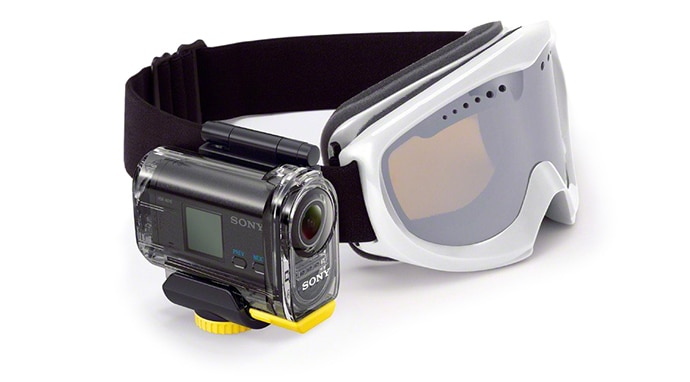
Pro audio: Sound completes the picture
Blown focus might drive a cinematographer crazy, but nothing loses an audience faster than unprofessional sound. That’s why experienced documentarians pay close attention to camera/microphone integration, microphone capsule selection and wireless microphone transmission quality. And that’s why professionals pair their Sony cameras with Sony mics and headphones.
Multi-Interface (MI) shoe
Featured in the PXW-FS7 and FS5, Sony’s Multi-Interface (MI) shoe is a tremendous convenience for documentary shooters. Among other capabilities, the shoe can provide DC power, audio connections and integrated on/off switching with Sony’s UWP-D Series wireless mic receivers. The UWP-D Series combines tremendous value with the convenience of automatic UHF channel selection, the sound quality of a digital compander, and the simplicity of pre-configured packages.
True to its name, the multi interface (MI) shoe of the PXW-FS7 and FS5 supports a variety of accessories, including a UWP-D Series wireless mic receiver (left) or an HVL-LBPC light, all sold separately.


Slot-in wireless mic receivers
Native on the PXW-X500 and PXW-X400 and featured on the CBK-55BK shoulder mount dock for the F5 and F55, Sony’s wireless mic receiver slot is a breakthrough in integration. Ready to work with Sony’s DWX Series digital wireless microphones, the slot-in receiver eliminates the need for signal cables, power cables and mounting brackets. The DWX Series wireless mic receiver becomes a seamless part of the camera. There’s even a communication channel from the camera back to the mic transmitter. So you can adjust the attenuator or reset the low-cut filter during the course of a shot. You can track battery charge in real time, so a dead battery will no longer catch you by surprise. And you can do it all, right from the camcorder’s viewfinder. No more running up to the talent, pulling off the body pack or fiddling.
The pair of antennas at the top of the PXW-X500 actually belongs to a DWX Series wireless microphone receiver, sold separately. For integrated operation, the receiver slots directly into the camera body.
Sony 7500 Series headphones
When it comes time to monitor audio, Sony’s MDR-7506 headphones are the de facto standard everywhere from newsgathering and field production to recording studios and live concert sound. The headphones deliver dependable sound quality, workhorse ruggedness and welcome isolation from ambient noise.
Ask any sound tech about Sony’s MDR-7506. They’re an industry classic.
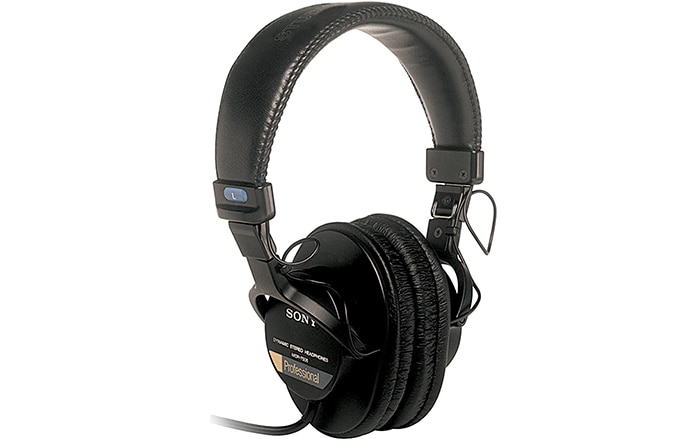
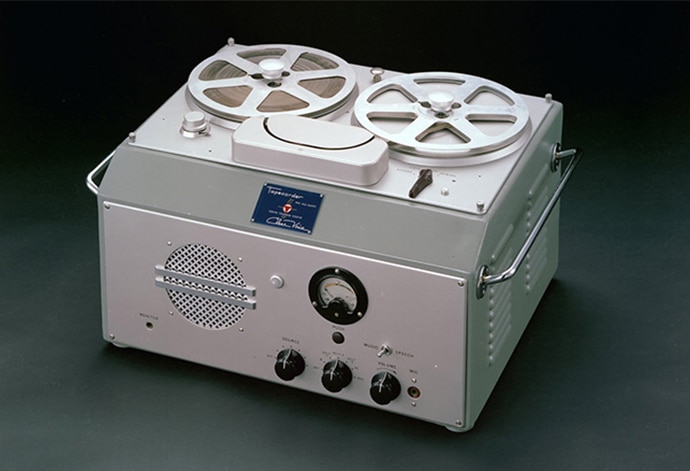
Sony and audio
While documentary shooters may associate Sony with cameras, our roots in audio run even deeper. Our very first product was an audio mixing console. Our first claim to fame was an audio tape recorder. Sony’s classic C-37A condenser microphone has been a mainstay of jazz and pop recordings. Sony headphones, lavaliere mics and wireless microphone systems are fixtures of the professional audio universe.
As this Type G tape recorder from 1950 attests, Sony was an audio company first.
Memory and storage: The simplicity of memory recording
Documentary film transports required meticulous maintenance and well-trained loaders. Tape transports required rotating head drums plus all types of cams, belts and pulleys. Today’s memory recording systems eliminate them all. With no moving parts, the recording system is reduced to a simple card slot. Meanwhile, the cards themselves are achieving unprecedented storage capacities and transfer speeds.
Superb performance
Today’s high-performance memory cards empower you with an incredible toolbox of digital feats, including 4K resolution, RAW recording and High Frame Rates. That’s why Sony insisted on uncommonly powerful memory cards. And that’s why we’ve developed a series of cards and card readers that balance high speed, large capacity, robust data management and affordability.
On the left, the AXS A Series card, with its supplied card adapter. In the middle, an SxS® Pro+ card. On the right, an advanced XQD™ card.
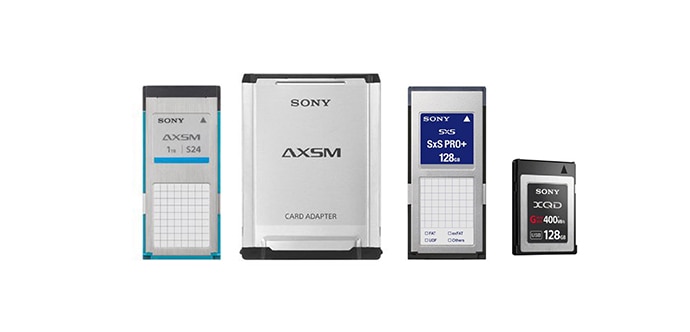

In addition to the SxS® cards themselves, our SxS card slots also accept affordable consumer media via Sony adapters. Of course, performance varies. Not all consumer media will support the read/write speeds necessary for cutting-edge professional recording.
In a pinch, consumer SDXC®, Memory Stick® and XQD™ cards can work in SxS slots via Sony’s MEAD-MS01, MEAD-SD02 and QDA-EX1 card adapters.
File-based workflows
Recording your documentary footage as data files opens up a world of workflow possibilities that were difficult, if not impossible to achieve with video tape. Now you can move footage across data interfaces like USB 3.0 and eSATA. Or share content over data networks like LANs and LTE. Or archive footage using data servers. Nonlinear editors and color correction packages from Apple, Adobe, Avid and others can ingest and accept Sony data recordings for fast, efficient postproduction. Restrictions apply.
You can protect your work with the Sony ODS-D77U Optical Disc Archive drive and cartridges.
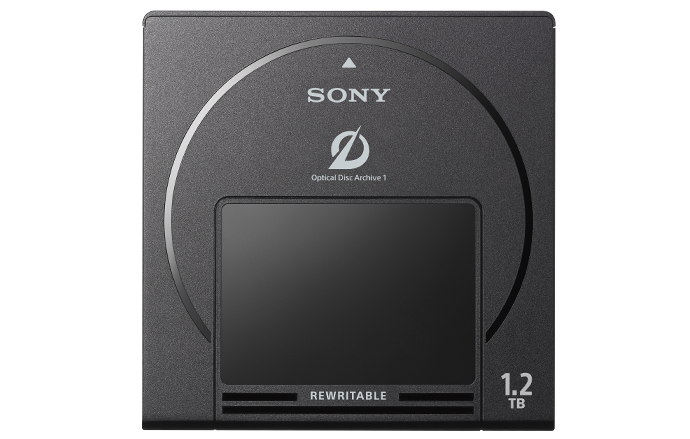

Data wrangling and backup
While master tapes can be used once and placed on the shelf, memory cards need to be carefully backed up, wiped and re-used. At minimum, you could get a USB card reader to copy content to your laptop’s hard drive. But professional productions typically need more robust, more meticulous backup procedures. Sony offers robust solutions, including Optical Disc Archive drives, Optical Disc media and professional portable storage.
Read more about Optical Disc Archives >
Read more about professional portable storage >
Sony rugged portable storage HDDs in unique storage case. Available in bus powered Thunderbolt / USB 3.0 interfaces (1 and 2TB) or FireWire™ 800 / USB 3.0 interfaces (500GB, 1 or 2TB).
Sony enables powerful possibilities in documentary capture. Options like RAW and 4K preserve the utmost in picture quality into post. Or go with space-saving, budget-friendly compression that nevertheless delivers spectacular imagery.
If you care about image quality, the news is good. Relentless advances in image sensors, digital processors and digital storage have empowered documentarians with picture quality options that far outstrip 16mm film and go a long way toward challenging the preeminence of 35mm film.
The ultimate camera capture system would record every nuance of light and shadow from the image sensor, preserving every detail from every pixel for full exploitation in post production. This is the concept behind RAW recording. RAW combines maximum resolution with maximum tonal range, for a ‘fat negative’ you can really manipulate in color correction.
What is RAW?
RAW originates from a design characteristic of single-sensor cameras. The single sensor can only detect one color per pixel: either red or green or blue.The color assignment is determined by a color filter array typically arranged in the checkerboard-like Bayer pattern. This original sensor data is the RAW signal, which preserves the maximum information from the sensor—prior to such camera processing as gamma encoding and color matrix, which ‘bake in’ many decisions that may be better left for post. The RAW signal cannot be viewed on a monitor. To view an RGB image, the missing color values must be calculated in a process called de-Bayering.
RAW data has only one color per pixel: Red, green or blue. De-Bayered data fills in the blanks, providing all three colors for every pixel.
[1] Single-chip image sensor with Bayer pattern color filter array
[2] RAW data
[3] Interpolation
[4] De-Bayered data
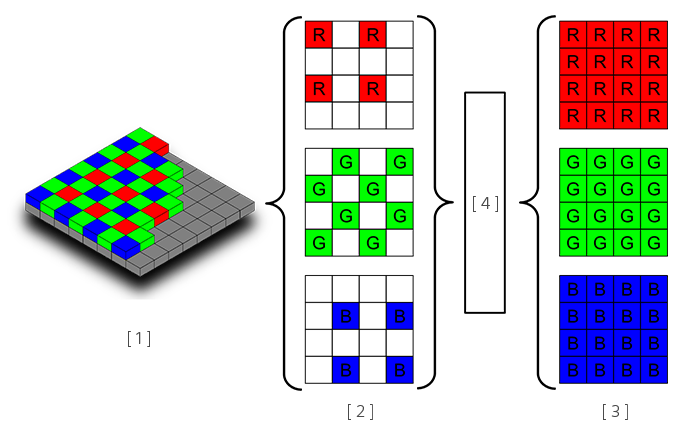

Is all RAW alike?
RAW picture quality varies greatly according to the specifics of the sensor and even the camera’s shuttering system. RAW images can incorporate varying degrees of digital compression. And RAW systems differ according to how accurately the sensor signal is converted to digital. The 16-bit linear capture of the Sony F55 and F5 is not only more precise than many other RAW systems; it deliberately preserves more tonal values than the human eye can differentiate.
Sony 16-bit linear RAW exceeds the human eye in the ability to distinguish fine gradations of sky and water in this F55 still from aerialexposures.com.
The 2K RAW alternative
If RAW recording has a downside, it’s the veritable fire hose of data. The Sony F55, F5 and FS7 work with the companion AXS-R5 RAW recorder, which operates at a net data rate of 960 megabits per second (at 24 fps). This eats up storage at 432 gigabytes per hour. That’s why Sony offers the option of 2K RAW recording of the full frame. Sony 2K RAW gives you everything you love about Super 35 cinematography with no crop factor, no telephoto conversion on your lenses. 2K RAW is a smart choice for HD productions and it’s just one quarter the data of 4K RAW.
At 108 gigabytes per hour, Sony 2K RAW delivers many of the advantages of 4K RAW. But it requires 75% less storage.
[1] 4K RAW [2] 2K RAW [3] 432 GB/hr [4] 108 GB/hr
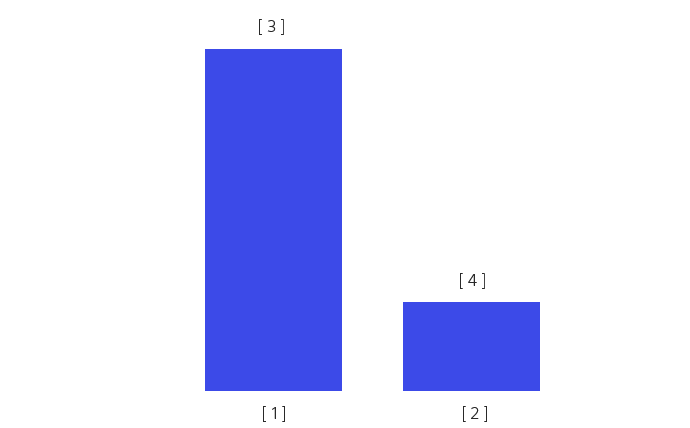
The beauty of 4K
Whether or not you plan to distribute your work in 4K, 4K recording is a beautiful thing. Thanks to ‘super-sampling’, a 4K camera captures visibly superior high definition, with texture, detail and contrast beyond the capabilities of conventional HD cameras.
What is 4K?
Standard definition was typically digitized at 720 pixels W x 480 pixels H. Full high definition is 1920 x 1080. 4K acquisition has more than four times the pixels: 4096 x 2160. A variant called Quad Full HD, QFHD or Ultra HD has exactly four times the pixels of Full HD, or 3840 x 1080.
All those pixels add up to a bigger, more engaging picture. Audiences can sit closer, becoming more immersed in your story, without being distracted by visible pixels, jagged edges or other picture artifacts. Landscapes become more sweeping, with a level of texture and detail closer to what we associate with 65mm film. Graphics, titles and credit rolls are much clearer. Beautifully shot 4K content on a 4K screen can be absolutely jaw-dropping.
[1] Standard definition 720 x 480
[2] Full HD 1920 x 1080
[3] 2K 2048 x 1080
[4] Quad Full HD 3840 x 2160
[5] 4K 4096 x 2160
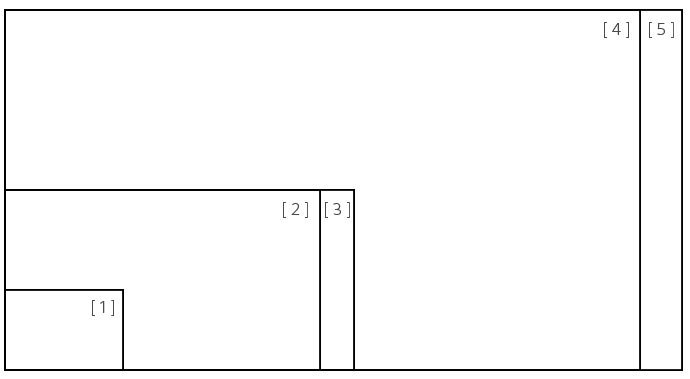
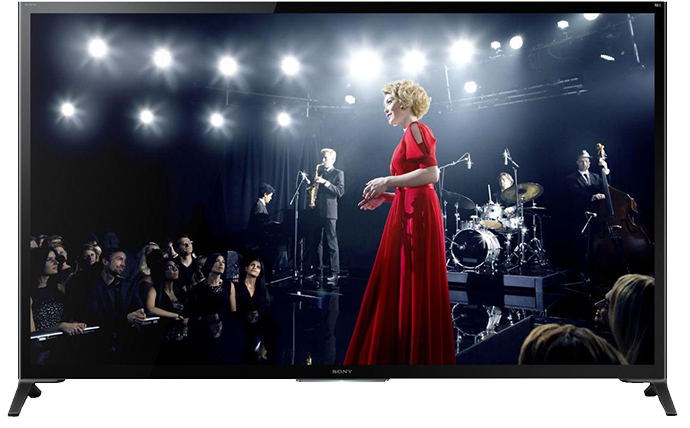
4K is both a production and distribution format. It’s an integral part of the digital cinema standard and over 13,000 cinema screens have Sony 4K projectors. It’s a trend in high-end televisions, and Sony now offers a whole range of 4K televisions, along with a 4K home server. The Netflix® and YouTube® services now offer 4K streaming and Amazon has announced their 4K streaming service.
Sony has 4K television models from 48.5 to 84.6 inches (viewable area, measured diagonally).
4K cameras provide three attractive strategies in today’s distribution environment.
Sony’s 4K sensor gives a gorgeous, super-sampled HD picture with visibly superiour texture, detail and high-frequency contrast that ordinary HD cameras cannot touch.
Derive your delivery format while preserving the original as a future-proof archive. Your master is ready for future 4K release.
You’re ready for the more than 13,000 movie theatres with Sony Digital Cinema 4K projectors and the new wave of 4K home entertainment.
Control time itself
You can underscore emotional points in your project, set a tone or set the scene by recording pictures at one speed and playing them back at another. High Frame Rates result in elegant slow motion. Low Frame Rates result in time lapse.
Up to 240 frames per second in Full HD
High Frame Rate shots can turn everyday actions into slow-motion ballet, a visual feast of elegant movement. These cameras deliver a maximum of 240 frames per second (fps) continuous shooting. If your project plays at the cinematic 24 fps, you get an astounding 10x super slow motion. Maximum frame rates depend on your choice of camera and recording format. Most of Sony’s high speed shooting modes deliver full quality. There’s no sacrifice in bit depth. There’s no ‘windowing’ of the sensor, no crop factor, no loss in angle of view. Sony offers one exception if 240 fps doesn’t quite satisfy your need for speed. In addition to 240 fps in Full HD (burst mode), Sony’s PXW-FS5 also records at 120, 480 and a phenomenal 960 fps. Played at 24p, 960 fps gives you 40x super slow motion (burst mode, Center Scan, at reduced resolution).
Earth Air Fire Water, a demonstration of the Sony F55 at 240 fps.
Slow and Quick (S and Q) motion
Time lapse enables flowers to open before your eyes, clouds to race by and sunrise to take just seconds. It’s a powerful tool for B-roll and atmosphere. Sony cameras deliver time lapse, overcranking and undercranking with the feature we call Slow and Quick (S and Q) Motion. This enables you to alter the narrative by speeding up or slowing down the action, choosing frame rates from 1 fps to the maximum in 1 fps increments.

Color, contrast and the XAVC codec
Today it is possible to record your projects with digital picture quality that was unheard of just a few years ago. You can pamper your pictures with the amazing detail of 4K resolution, the drama of high frame rates, the extended grayscale of 10-bit precision and the robust color of 4:2:2 sampling. Of course, each one of these advances requires more digital bandwidth, more storage space, and more file transfer time than conventional HD recording (1080/24p, 8-bit, 4:2:0 color). And the higher the recording bitrate, the less time you’ll be able to record on a given memory card. But what if you wanted to have your cake and eat it, too? What if you want ultimate picture quality combined with money-saving data rates? To satisfy all these requirements, Sony created the XAVC® codec family.
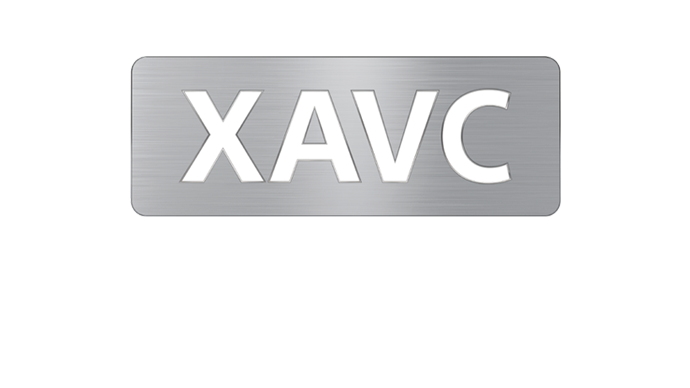
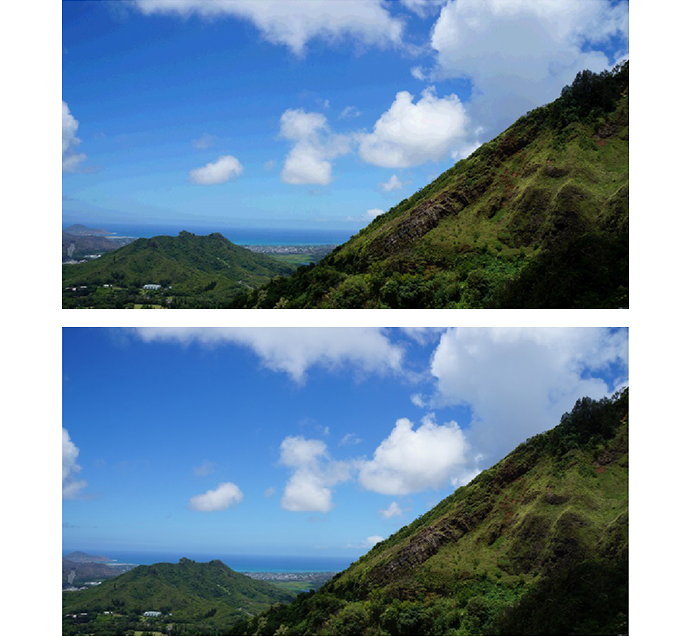
The XAVC codec and 10-bit precision
For decades, the workhorse digital formats have all used 8-bit digital precision, resulting in about 250 grayscale levels for each channel (Y, Cb and Cr). While 8-bit recording is good for broadcasting, it’s somewhat fragile in color correction. When you start to lift shadows or compress highlights, you may see ‘banding’ across areas of flat color, such as sky. That’s why more productions are moving toward the more precise, more robust 10-bit recording, which provides about 1,000 grayscale levels per channel. Sony’s XAVC codec delivers 10-bit precision without any penalty in storage costs.
Without enough precision, color correction can cause banding, as in the sky (top image). The XAVC codec delivers 10-bit recording for images that hold up better in post (bottom). Simulated images for illustration purposes.
The XAVC™ codec and 4:2:2 sampling
Many entry-level camcorders save on bandwidth by using 4:1:1 or 4:2:0 color sampling. These systems provide full resolution for the chrominance or Y channel, while using only quarter resolution for the two color difference channels (Cb and Cr). While 4:1:1 and 4:2:0 images look fine at a glance, on close observation you actually see blur at the edges where different colors meet. Professionals know that 4:2:2 color is substantially better, with twice as many color samples as 4:2:0 or 4:1:1. Thanks to advanced compression technology, the XAVC codec steps up to 4:2:2 color without a corresponding increase in storage costs.
4:2:0 color sampling preserves a black-and-white Y sample for every pixel, but saves color Cb and Cr samples for only one-fourth the pixels. In comparison, 4:2:2 preserves twice the color information, for naturally sharper images.
| 4:2:0 color sampling | 4:2:2 color sampling |
|---|---|
| Y: 1920 x 1080 | Y: 1920 x 1080 |
| Cb: 960 x 520 | Cb: 960 x 1080 |
| Cr: 960 x 540 | Cr: 960 x 1080 |
XAVC codec and 4K
4K is a glorious image format. But 4K requires you to record 8.8 million pixels, more than four times the pixels of Full HD. So if you want 4K without spending quite so much money on storage capacity, you want advanced compression technology. The XAVC codec is a smart choice.
The XAVC codec and HDR
In a similar way, 240 fps High Frame Rate shooting requires ten times the data storage of conventional 24 fps recording. The XAVC codec helps tame the data flow, making High Frame Rate a more practical option.
The XAVC codec and long recording times
Documentarians must often contend with a stubborn practical question: how long are the loads? The magic of the XAVC codec, especially in its XAVC-L (Long GOP) form, is the ability to capture stunning 10-bit, 4:2:2 Full HD content at a budget-friendly 50, 35 or even 25 megabits per second. So you can record hour after hour of content on a single memory card!
Imagine more than eight hours of spectacular HD content on a single, 128 GB card. The PXW-FS7 and FS5 deliver with the help of the Long GOP version of Sony’s XAVC codec.
| XAVC-L 50 mbps | XAVC-L 35 mbps | XAVC-L 25 mbps |
|---|---|---|
| 262 mins, FULL HD | 374 mins, FULL HD | 524 mins, FULL HD |
| QD-G128A (128 GB) | QD-G128A (128 GB) | QD-G128A (128 GB) |
XAVC codec flavors
The XAVC codec works so well because it employs a fresh generation of compression tools, firmly rooted in industry-standard H.264/MPEG-4 Advanced Video Coding. Sony should know; we helped develop H.264. To support the widest range of production agendas, Sony now offers the XAVC codec in three different ways.
XAVC-I. The Intra-frame only version delivers exquisite pictures quality. Using all Intra frames means consistent picture quality, even in scenes with fast motion. Sophisticated tools like Sequence Parameter Set bits, Picture Parameter Set bits and Multi-Pass Encoding yield images of uncommon quality. Tech specs:
- MXF wrapper
- 10-bit
- 4:2:2
- Full HD at 89 Mbps (23.98p)
XAVC-L. The Long-GOP (L) version takes advantage of the similarity among video frames to achieve even greater compression ratios. You get stunning quality and extremely modest bitrates. Tech specs:
- MXF wrapper
- 10-bit (HD)
- 4:2:2 (HD)
- Full HD at 50, 35 or 25 Mbps
XAVC-S. The next-generation consumer video codec. Tech specs:
- MP4 wrapper
- 8-bit
- 4:2:0
- Full HD at 60 or 50 Mbps
Other codecs, other choices
While users are delighted with the results they’re getting with the XAVC codec, Sony recognizes that one size no longer fits all. That’s why these documentary cameras offer a range of Sony and non-Sony codecs.
SR File. This ‘visually lossless’ HD codec has stood behind a generation of major Hollywood features and episodic television. Tech specs:
- MXF wrapper
- 12-bit or 10-bit
- 4:4:4 or 4:2:2
- Full HD at 880, 440 or 220 Mbps
MPEG HD 422. The workhorse format of XDCAM™ HD 422 gear is well accepted by broadcasters. Tech specs:
- MXF wrapper
- 8-bit
- 4:2:2
- Full HD at 50 Mbps
AVCHD®. For workflows already committed to this broadly compatible, widely-used codec.
Apple® ProRes 422 HD. The native format of Final Cut Pro® editing and a popular choice for direct-to-edit production. Available as an extra-cost option on the PMW-F55, PMW-F5, PXW-FS7 and PXW-X500.
Avid DNxHD™ HD. The native format of Avid® editing systems is another popular choice for streamlined postproduction. Available as an extra-cost option on the PMW-F55, PMW-F5 and PXW-X500.
Sony has the solution for the producer’s desk, where content review needs to be as simple as hitting the Play button. For digital signage and trade shows, where playback needs to absolutely foolproof. For the field, where you don’t always have access to a power outlet. And for 4K jobs, where you may not have a major investment in computer processor cores, GPUs and interface cards. Presenting Sony’s PMW-PZ1, the simple, affordable memory player that supports a range of codecs, frame rates and resolutions.
The rear panel supports HDMI 4K output, four 3G/HD SDI outputs and L/R audio out, while the front panel offers a USB 3.0 interface for playback from external drives and a second USB port for connecting a mouse.
- Simple playback, with the familiar Play, Stop, Previous and Next buttons that everyone knows and understands
- Flexible codec support, including XAVC™ Intra and XAVC Long at launch, plus MPEG HD422, MPEG HD (420) and XAVC S playback with firmware upgrade.
- Choice of resolutions including 4K (4096 x 2160), Quad Full HD (3840 x 2160) and Full HD (1920 x 1080)
- Choice of frame rates from 24p to 60p
- Plays SxS® cards directly


